check engine TOYOTA COROLLA HATCHBACK 2022 (in English) Owner's Guide
[x] Cancel search | Manufacturer: TOYOTA, Model Year: 2022, Model line: COROLLA HATCHBACK, Model: TOYOTA COROLLA HATCHBACK 2022Pages: 758, PDF Size: 155.26 MB
Page 320 of 758
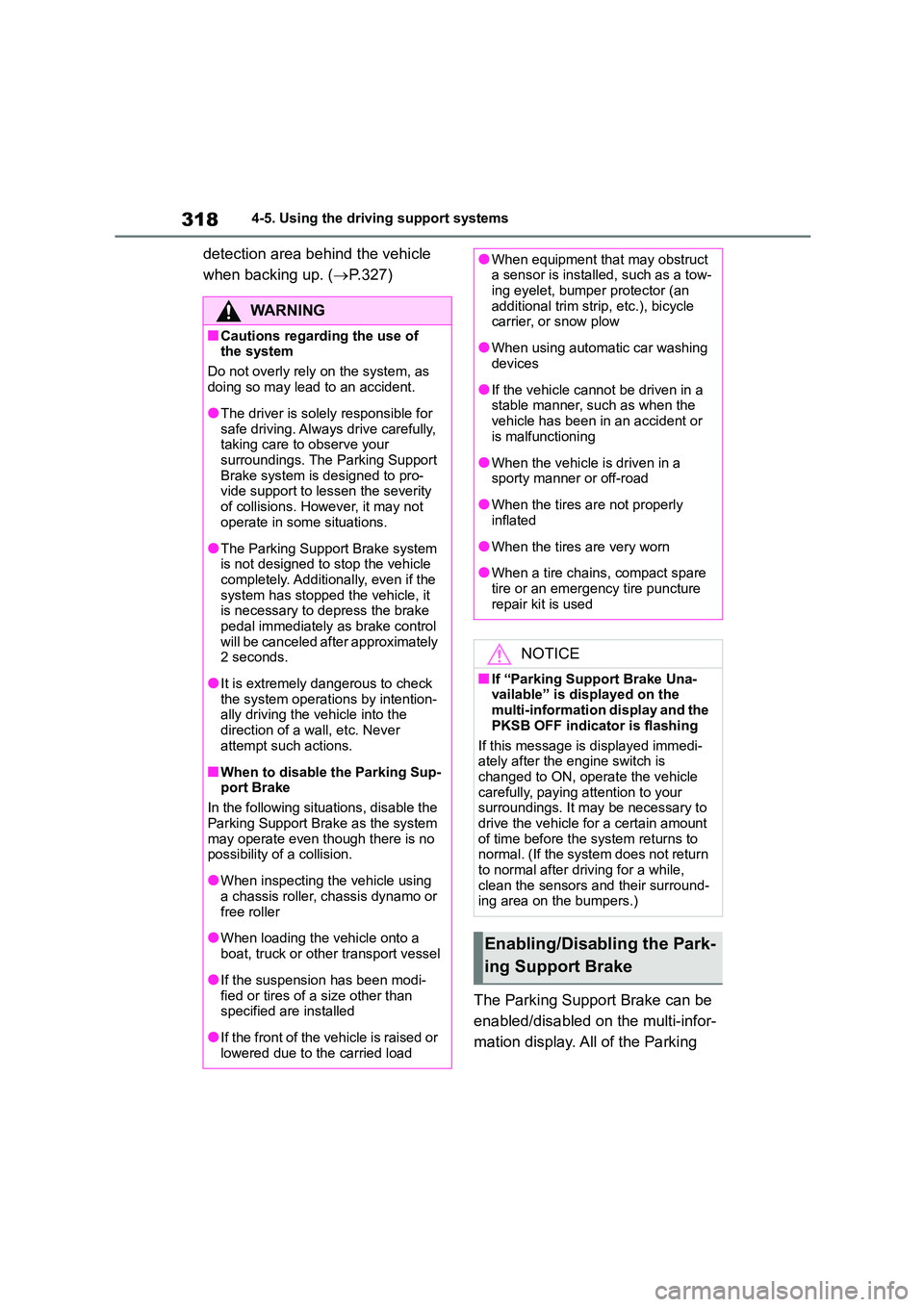
3184-5. Using the driving support systems
detection area behind the vehicle
when backing up. ( P.327)
The Parking Support Brake can be
enabled/disabled on the multi-infor-
mation display. All of the Parking
WA R N I N G
■Cautions regarding the use of
the system
Do not overly rely on the system, as
doing so may lead to an accident.
●The driver is solely responsible for safe driving. Always drive carefully,
taking care to observe your
surroundings. The Parking Support Brake system is designed to pro-
vide support to lessen the severity
of collisions. However, it may not operate in some situations.
●The Parking Support Brake system is not designed to stop the vehicle
completely. Additionally, even if the
system has stopped the vehicle, it is necessary to depress the brake
pedal immediately as brake control
will be canceled after approximately 2 seconds.
●It is extremely dangerous to check the system operatio ns by intention-
ally driving the vehicle into the
direction of a wall, etc. Never attempt such actions.
■When to disable the Parking Sup-port Brake
In the following situations, disable the
Parking Support Br ake as the system may operate even though there is no
possibility of a collision.
●When inspecting the vehicle using
a chassis roller, chassis dynamo or
free roller
●When loading the vehicle onto a
boat, truck or other transport vessel
●If the suspension has been modi-
fied or tires of a size other than specified are installed
●If the front of the vehicle is raised or lowered due to the carried load
●When equipment that may obstruct a sensor is installed, such as a tow-
ing eyelet, bumper protector (an
additional trim strip, etc.), bicycle carrier, or snow plow
●When using automatic car washing devices
●If the vehicle cannot be driven in a stable manner, such as when the
vehicle has been in an accident or
is malfunctioning
●When the vehicle is driven in a
sporty manner or off-road
●When the tires are not properly
inflated
●When the tires are very worn
●When a tire chains, compact spare
tire or an emergency tire puncture
repair kit is used
NOTICE
■If “Parking Support Brake Una- vailable” is displayed on the
multi-information display and the
PKSB OFF indicator is flashing
If this message is displayed immedi-
ately after the engine switch is
changed to ON, operate the vehicle carefully, paying attention to your
surroundings. It may be necessary to
drive the vehicle for a certain amount of time before the system returns to
normal. (If the system does not return
to normal after driving for a while, clean the sensors and their surround-
ing area on the bumpers.)
Enabling/Disabling the Park-
ing Support Brake
Page 348 of 758
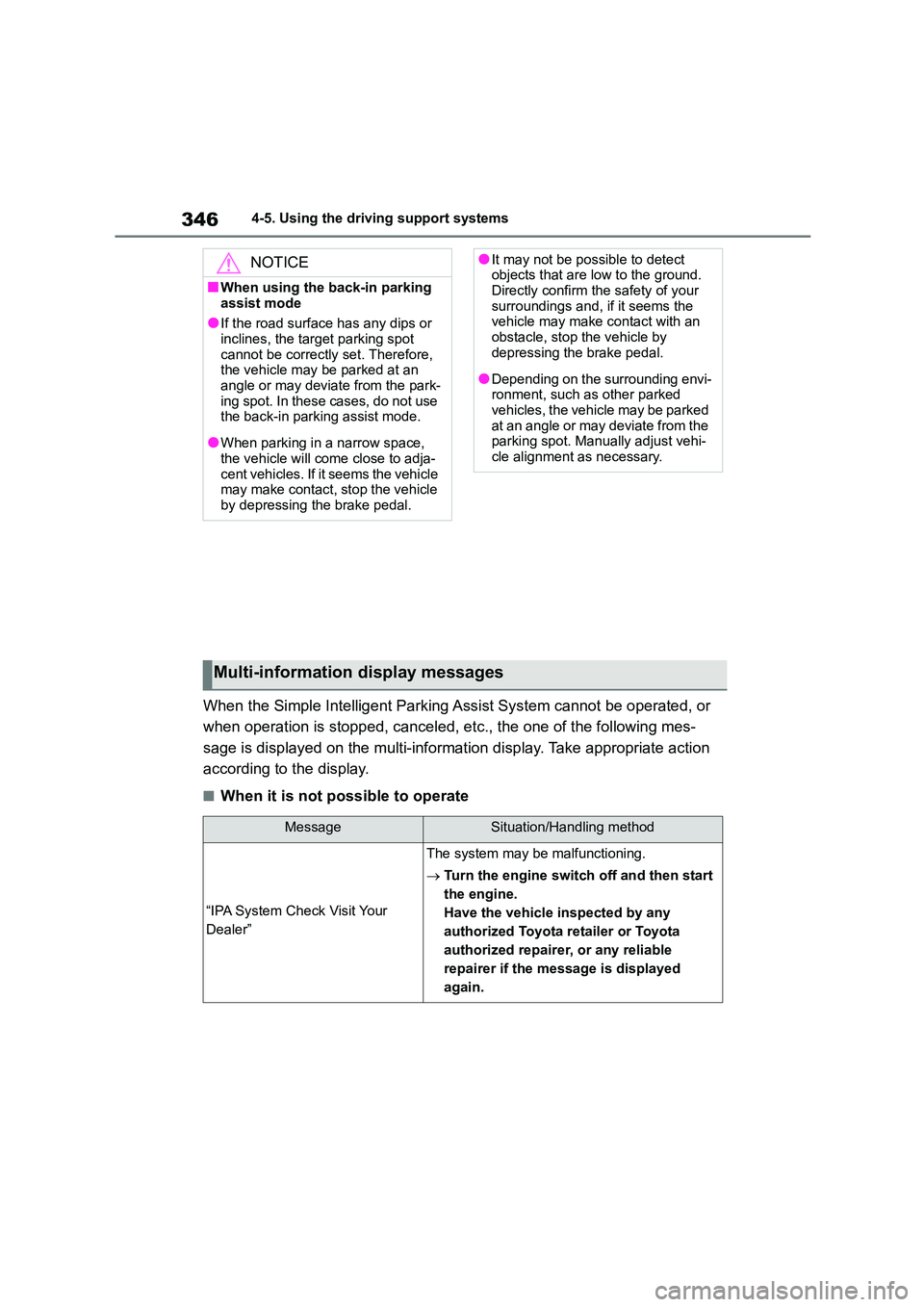
3464-5. Using the driving support systems
When the Simple Intelligent Parking Assist System cannot be operated, or
when operation is stopped, canceled, etc., the one of the following mes-
sage is displayed on the multi-information display. Take appropriate action
according to the display.
■When it is not possible to operate
NOTICE
■When using the back-in parking
assist mode
●If the road surface has any dips or inclines, the target parking spot
cannot be correctly set. Therefore,
the vehicle may be parked at an angle or may deviate from the park-
ing spot. In these cases, do not use
the back-in parking assist mode.
●When parking in a narrow space,
the vehicle will come close to adja-
cent vehicles. If it seems the vehicle may make contact, stop the vehicle
by depressing the brake pedal.
●It may not be possible to detect objects that are low to the ground.
Directly confirm the safety of your
surroundings and, if it seems the vehicle may make contact with an
obstacle, stop the vehicle by
depressing the brake pedal.
●Depending on the surrounding envi-
ronment, such as other parked vehicles, the vehicle may be parked
at an angle or may deviate from the
parking spot. Manually adjust vehi- cle alignment as necessary.
Multi-information display messages
MessageSituation/Handling method
“IPA System Check Visit Your
Dealer”
The system may be malfunctioning.
Turn the engine switch off and then start
the engine.
Have the vehicle inspected by any
authorized Toyota retailer or Toyota
authorized repairer, or any reliable
repairer if the message is displayed
again.
Page 379 of 758
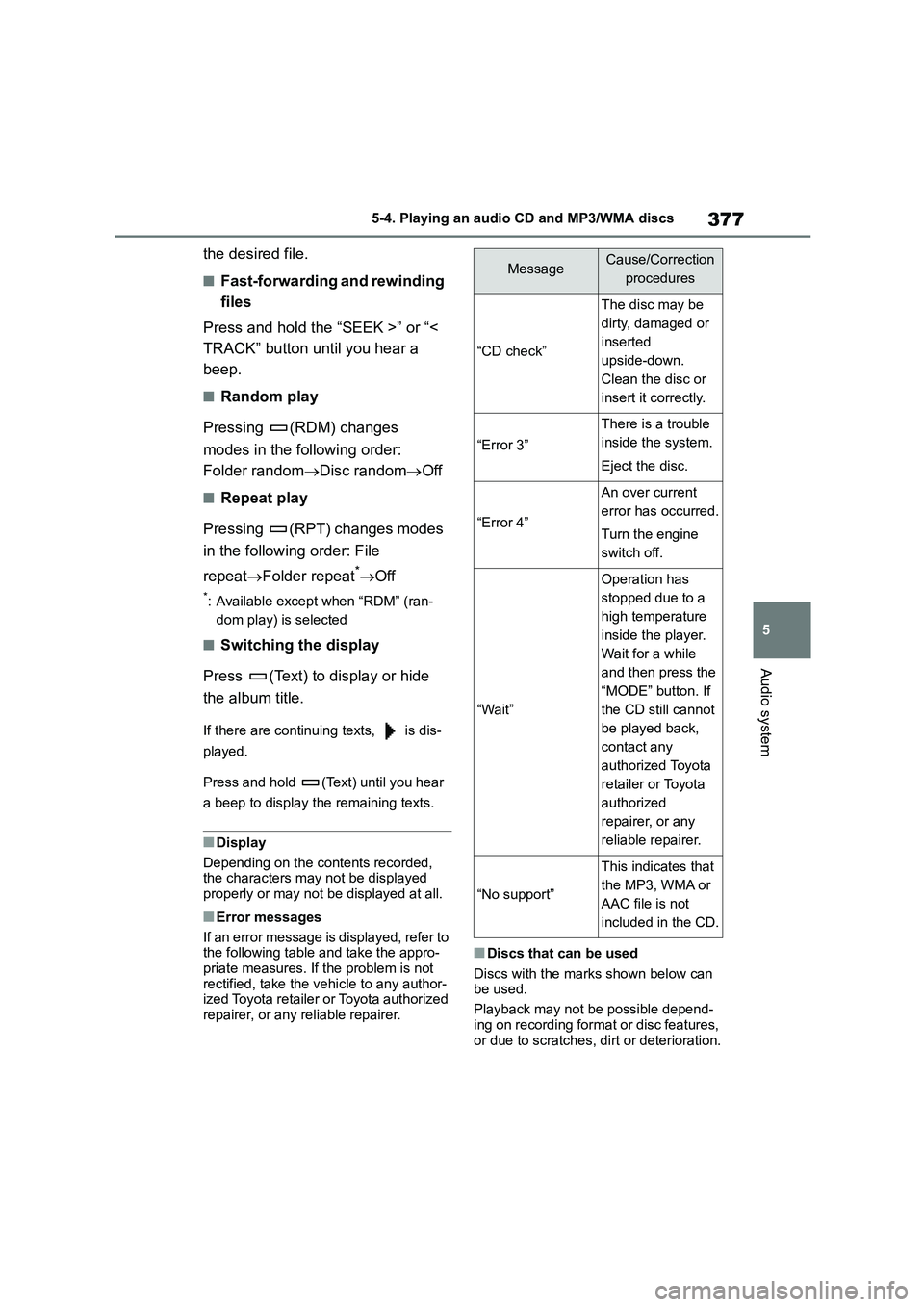
377
5
5-4. Playing an audio CD and MP3/WMA discs
Audio system
the desired file.
■Fast-forwarding and rewinding
files
Press and hold the “SEEK >” or “<
TRACK” button until you hear a
beep.
■Random play
Pressing (RDM) changes
modes in the following order:
Folder random Disc randomOff
■Repeat play
Pressing (RPT) changes modes
in the following order: File
repeat Folder repeat*Off
*: Available except when “RDM” (ran-
dom play) is selected
■Switching the display
Press (Text) to display or hide
the album title.
If there are continuing texts, is dis-
played.
Press and hold (Text) until you hear
a beep to display the remaining texts.
■Display
Depending on the contents recorded,
the characters may not be displayed
properly or may not be displayed at all.
■Error messages
If an error message is displayed, refer to
the following table and take the appro-
priate measures. If the problem is not rectified, take the vehicle to any author-
ized Toyota retailer or Toyota authorized
repairer, or any reliable repairer.
■Discs that can be used
Discs with the marks shown below can be used.
Playback may not be possible depend-
ing on recording format or disc features, or due to scratches, dirt or deterioration.
MessageCause/Correction
procedures
“CD check”
The disc may be
dirty, damaged or
inserted
upside-down.
Clean the disc or
insert it correctly.
“Error 3”
There is a trouble
inside the system.
Eject the disc.
“Error 4”
An over current
error has occurred.
Turn the engine
switch off.
“Wait”
Operation has
stopped due to a
high temperature
inside the player.
Wait for a while
and then press the
“MODE” button. If
the CD still cannot
be played back,
contact any
authorized Toyota
retailer or Toyota
authorized
repairer, or any
reliable repairer.
“No support”
This indicates that
the MP3, WMA or
AAC file is not
included in the CD.
Page 461 of 758
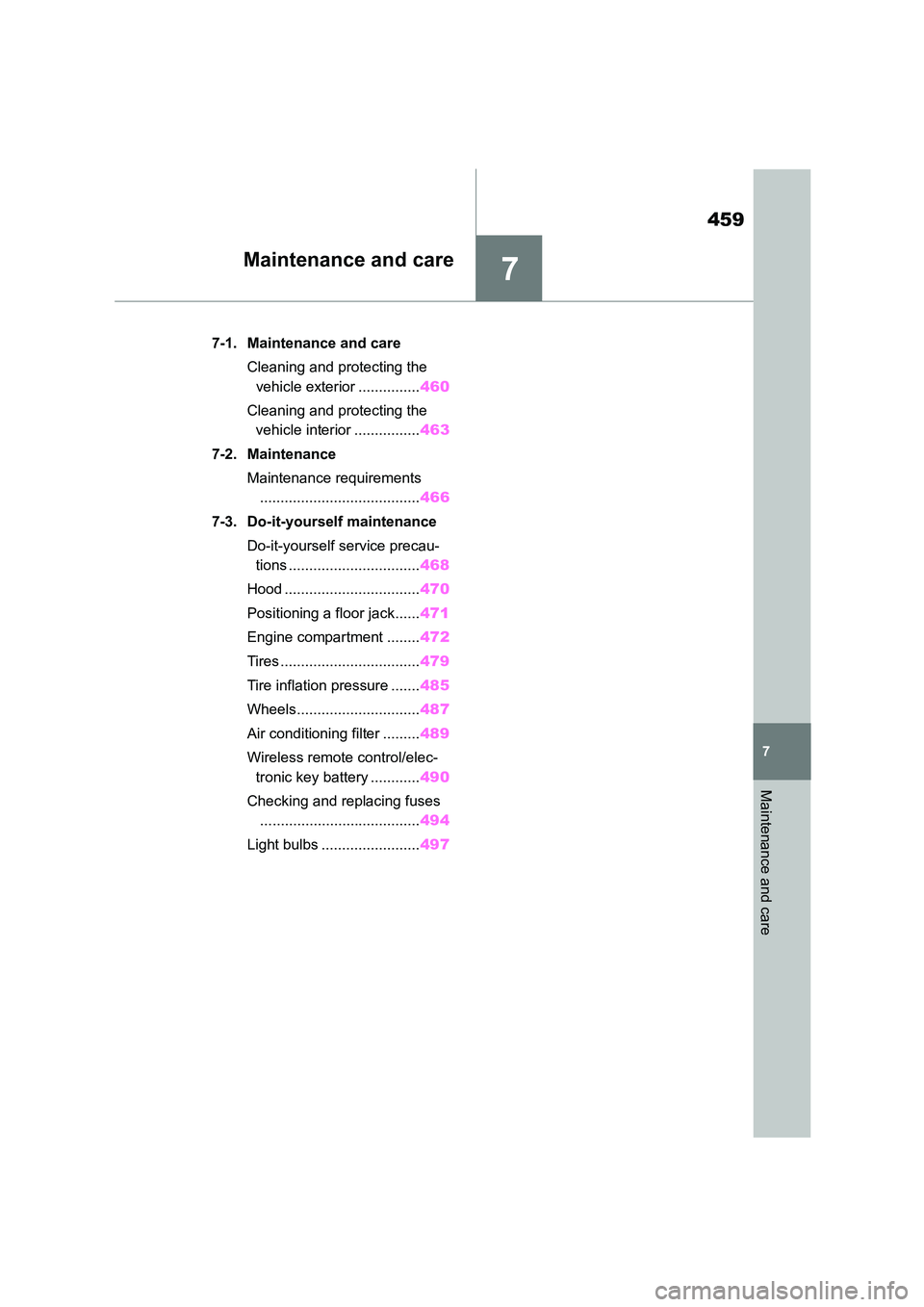
7
459
7
Maintenance and care
Maintenance and care
.7-1. Maintenance and care
Cleaning and protecting the
vehicle exterior ............... 460
Cleaning and protecting the
vehicle interior ................ 463
7-2. Maintenance
Maintenance requirements
....................................... 466
7-3. Do-it-yourself maintenance
Do-it-yourself service precau-
tions ................................ 468
Hood ................................. 470
Positioning a floor jack ...... 471
Engine compartment ........ 472
Tires .................................. 479
Tire inflation pressure ....... 485
Wheels.............................. 487
Air conditioning filter ......... 489
Wireless remote control/elec-
tronic key battery ............ 490
Checking and replacing fuses
....................................... 494
Light bulbs ........................ 497
Page 469 of 758

467
7
7-2. Maintenance
Maintenance and care
request that a record of maintenance
be kept.
■Does your vehicle need repairs?
Be on the alert for changes in perfor- mance and sounds, and visual tip-offs
that indicate service is needed. Some
important clues are:
●Engine missing, stumbling or pinging
●Appreciable loss of power
●Strange engine noises
●A fluid leak under the vehicle (How-
ever, water dripping from the air con- ditioning system after use is normal.)
●Change in exhaust sound (This may indicate a dangerous carbon monox-
ide leak. Drive with the windows open
and have the exhaust system checked immediately.)
●Flat-looking tires, excessive tire squeal when cornering, uneven tire
wear
●Vehicle pulls to one side when driven
straight on a level road
●Strange noises related to suspension
movement
●Loss of brake effectiveness, spongy
feeling brake pedal or clutch pedal
(vehicles with a manual transmission),
pedal almost touches the floor, vehicle pulls to one side when braking
●Engine coolant temperature continu-ally higher than normal ( P.89, 93)
If you notice any of these clues, take
your vehicle to any authorized Toyota retailer or Toyota authorized repairer, or
any reliable repairer as soon as possi-
ble. Your vehicle may need adjustment or repair.
Page 474 of 758

4727-3. Do-it-yourself maintenance
Washer fluid tank (P.477)
Engine coolant reservoir ( P. 4 7 5 )
Fuse boxes ( P.494)
Engine oil filler cap ( P.473)
Engine oil level dipstick ( P.472)
Intercooler coolant reservoir ( P.475)
Battery ( P.476)
Radiator ( P.476)
Condenser ( P.476)
Electric cooling fans
With the engine at operating tem-
perature and turned off, check the
oil level on the dipstick.
■Checking the engine oil
1 Park the vehicle on level
ground. After warming up the
Engine compartment
Components
Checking and adding the
engine oil
Page 475 of 758
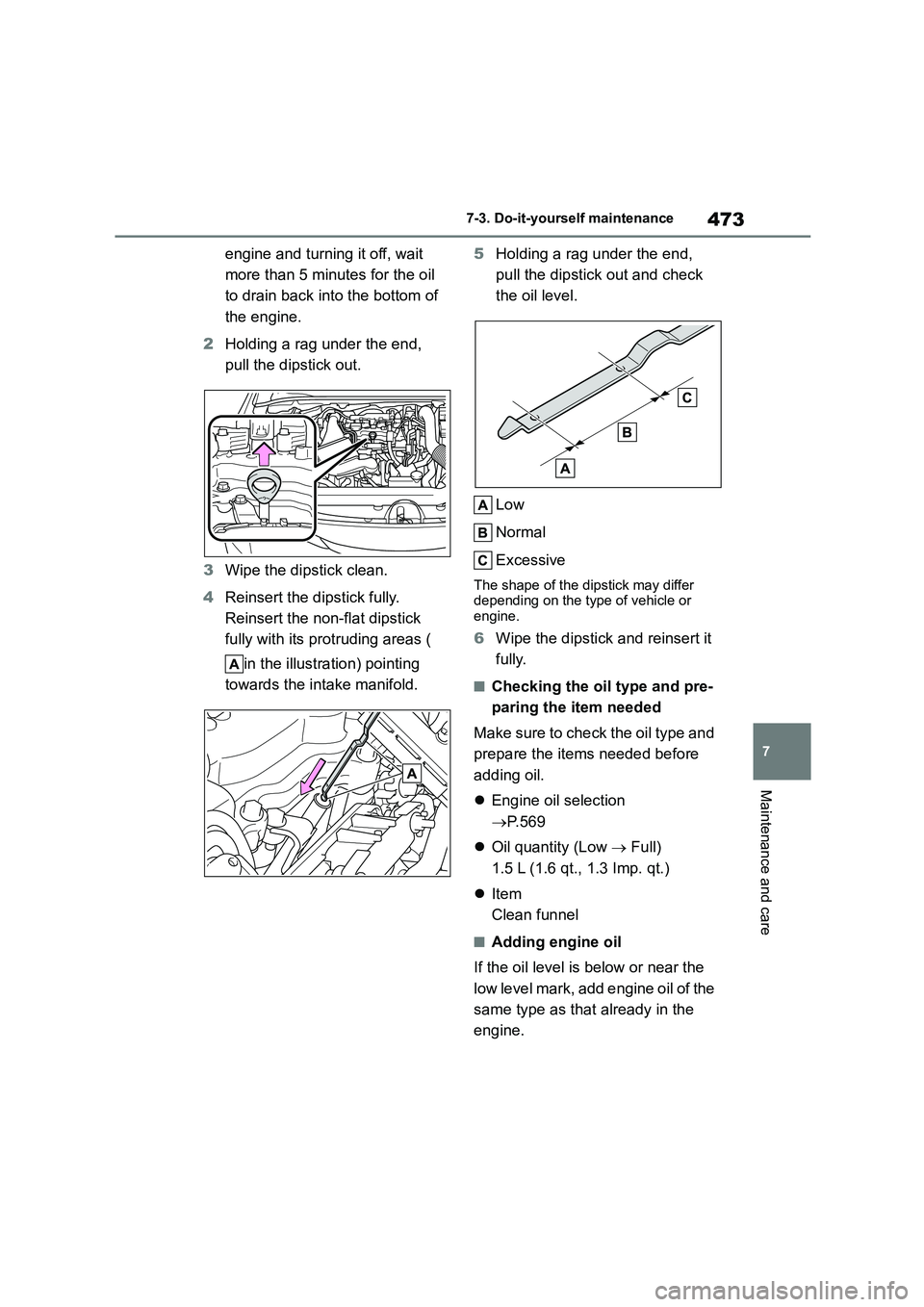
473
7
7-3. Do-it-yourself maintenance
Maintenance and care
engine and turning it off, wait
more than 5 minutes for the oil
to drain back into the bottom of
the engine.
2 Holding a rag under the end,
pull the dipstick out.
3 Wipe the dipstick clean.
4 Reinsert the dipstick fully.
Reinsert the non-flat dipstick
fully with its protruding areas (
in the illustration) pointing
towards the intake manifold.
5 Holding a rag under the end,
pull the dipstick out and check
the oil level.
Low
Normal
Excessive
The shape of the dipstick may differ
depending on the type of vehicle or engine.
6 Wipe the dipstick and reinsert it
fully.
■Checking the oil type and pre-
paring the item needed
Make sure to check the oil type and
prepare the items needed before
adding oil.
Engine oil selection
P.569
Oil quantity (Low Full)
1.5 L (1.6 qt., 1.3 Imp. qt.)
Item
Clean funnel
■Adding engine oil
If the oil level is below or near the
low level mark, add engine oil of the
same type as that already in the
engine.
Page 476 of 758

4747-3. Do-it-yourself maintenance
1Remove the oil filler cap by turn-
ing it counterclockwise.
2 Add engine oil slowly, checking
the dipstick.
3 Install the oil filler cap by turning
it clockwise.
■Engine oil consumption
A certain amount of engine oil will be
consumed while driving. In the following situations, oil consumption may
increase, and engine oil may need to be
refilled in between oil maintenance inter- vals.
●When the engine is new, for example directly after purchasing the vehicle or
after replacing the engine
●If low quality oil or oil of an inappropri-
ate viscosity is used
●When driving at high engine speeds
or with a heavy load, when towing, or
when driving while accelerating or decelerating frequently
●When leaving the engine idling for a long time, or when driving frequently
through heavy traffic
■After changing the engine oil
The engine oil maintenance data should
be reset. Perform the following proce- dures:
1 Press or of the meter con-
trol switch to select .
2 Press or to select “Vehicle
Settings” and then press and hold
.
3 Press or to select “Oil Main-
tenance” and then press .
4 Press or to select “Yes” and
then press .
A message will be displayed on the
multi-information display when the reset
procedure has been completed.
WA R N I N G
■Used engine oil
●Used engine oil contains poten-
tially harmful contaminants which
may cause skin disorders such as inflammation and skin cancer, so
care should be taken to avoid pro-
longed and repeated contact. To remove used engine oil from your
skin, wash thoroughly with soap
and water.
●Dispose of used oil and filters only
in a safe and acceptable manner. Do not dispose of used oil and fil-
ters in household trash, in sewers
or onto the ground. Call any authorized Toyota retailer
or Toyota authorized repairer, or
any reliable repairer, service station or auto parts store for information
concerning recycling or disposal.
●Do not leave used engine oil within
the reach of children.
NOTICE
■To prevent serious engine dam- age
Check the oil level on a regular basis.
Page 477 of 758
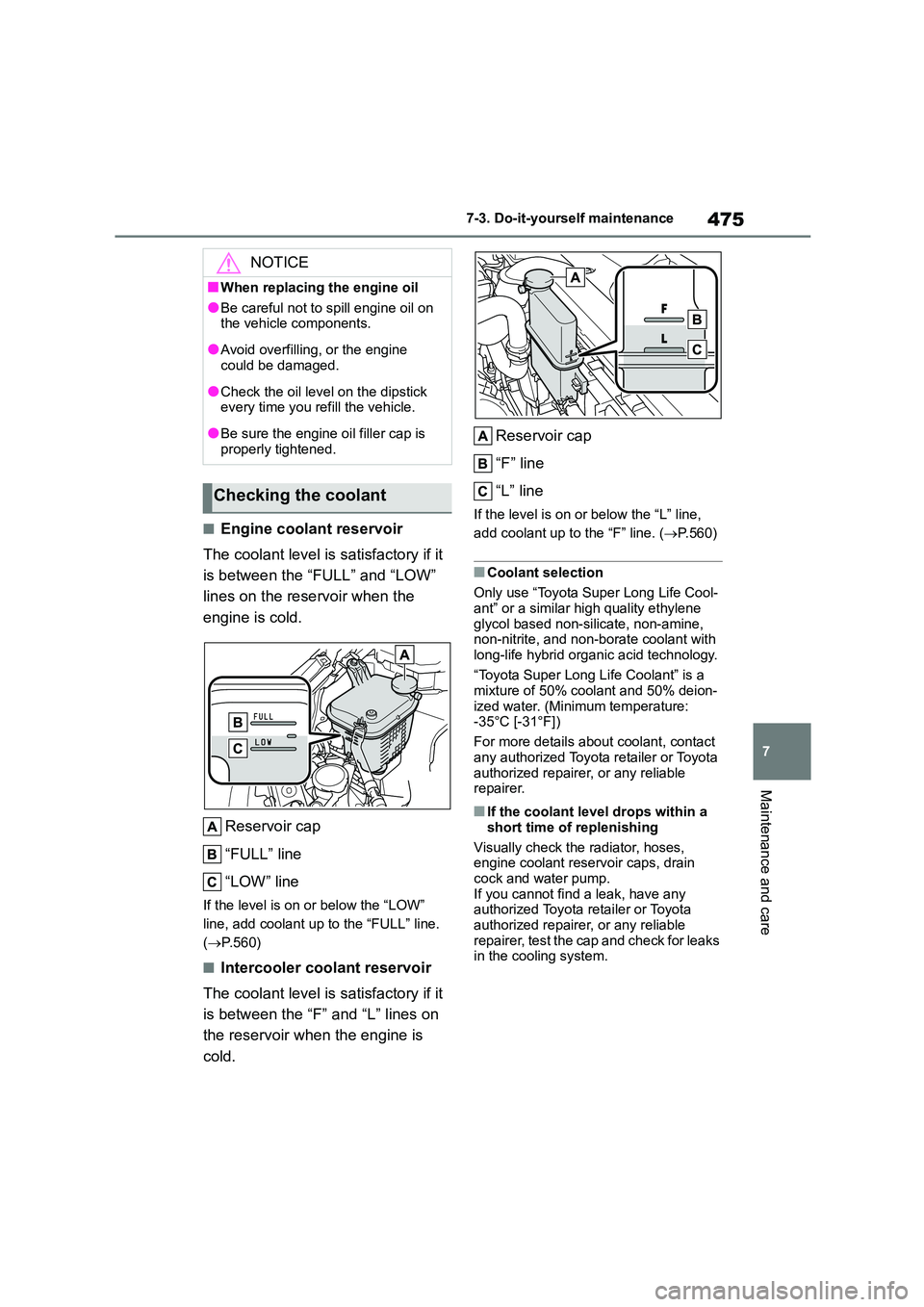
475
7
7-3. Do-it-yourself maintenance
Maintenance and care
■Engine coolant reservoir
The coolant level is satisfactory if it
is between the “FULL” and “LOW”
lines on the reservoir when the
engine is cold.
Reservoir cap
“FULL” line
“LOW” line
If the level is on or below the “LOW”
line, add coolant up to the “FULL” line.
( P.560)
■Intercooler coolant reservoir
The coolant level is satisfactory if it
is between the “F” and “L” lines on
the reservoir when the engine is
cold.
Reservoir cap
“F” line
“L” line
If the level is on or below the “L” line,
add coolant up to the “F” line. ( P.560)
■Coolant selection
Only use “Toyota Super Long Life Cool-
ant” or a similar high quality ethylene
glycol based non-silicate, non-amine, non-nitrite, and non-borate coolant with
long-life hybrid organic acid technology.
“Toyota Super Long Life Coolant” is a mixture of 50% coolant and 50% deion-
ized water. (Minimum temperature:
-35°C [-31°F])
For more details about coolant, contact
any authorized Toyota retailer or Toyota
authorized repairer, or any reliable repairer.
■If the coolant level drops within a
short time of replenishing
Visually check the radiator, hoses, engine coolant reservoir caps, drain
cock and water pump.
If you cannot find a leak, have any authorized Toyota retailer or Toyota
authorized repairer, or any reliable
repairer, test the cap and check for leaks in the cooling system.
NOTICE
■When replacing the engine oil
●Be careful not to spill engine oil on
the vehicle components.
●Avoid overfilling, or the engine
could be damaged.
●Check the oil level on the dipstick
every time you refill the vehicle.
●Be sure the engine oil filler cap is
properly tightened.
Checking the coolant
Page 478 of 758
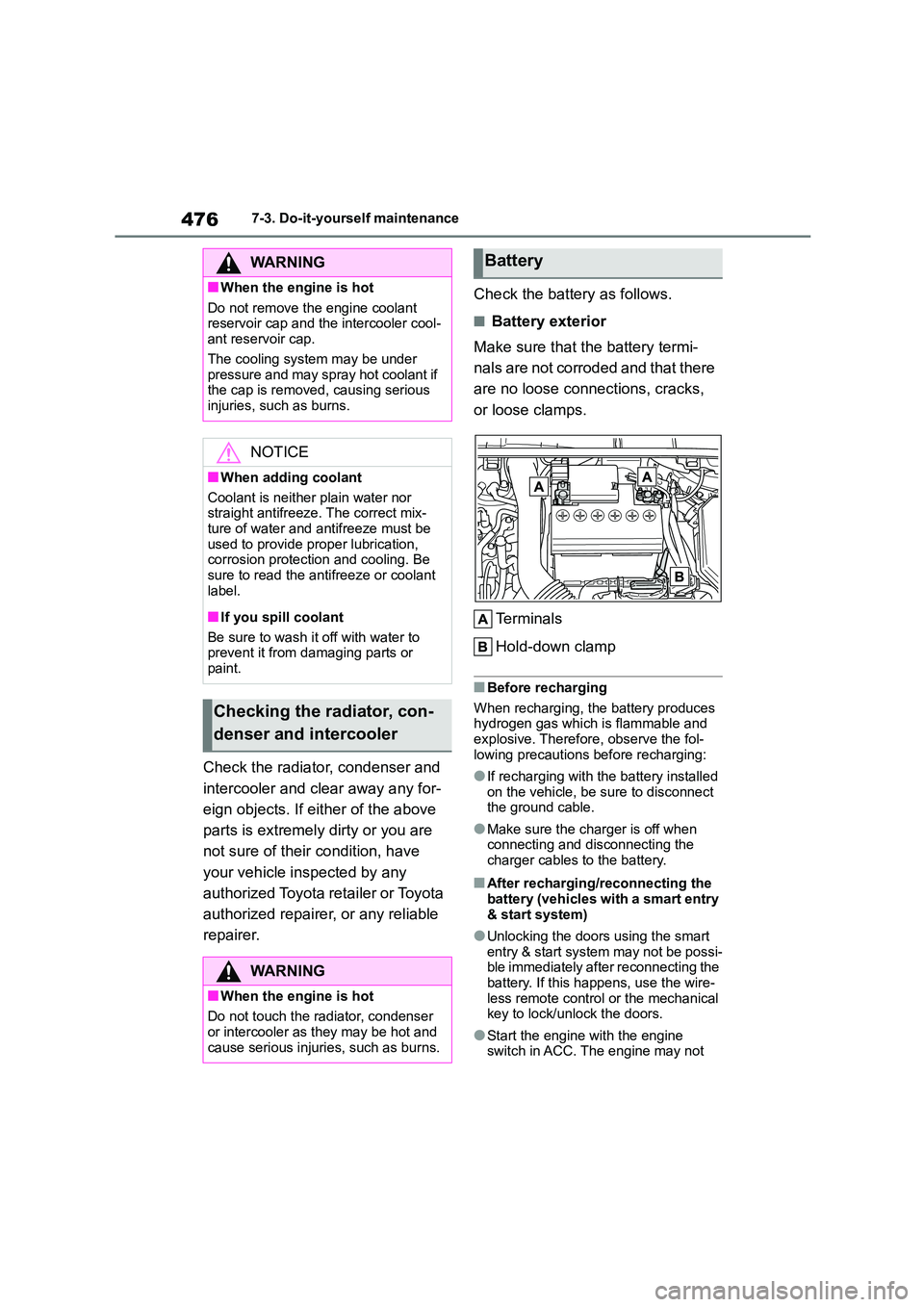
4767-3. Do-it-yourself maintenance
Check the radiator, condenser and
intercooler and clear away any for-
eign objects. If either of the above
parts is extremely dirty or you are
not sure of their condition, have
your vehicle inspected by any
authorized Toyota retailer or Toyota
authorized repairer, or any reliable
repairer.
Check the battery as follows.
■Battery exterior
Make sure that the battery termi-
nals are not corroded and that there
are no loose connections, cracks,
or loose clamps.
Terminals
Hold-down clamp
■Before recharging
When recharging, the battery produces hydrogen gas which is flammable and
explosive. Therefore, observe the fol-
lowing precautions before recharging:
●If recharging with the battery installed
on the vehicle, be sure to disconnect the ground cable.
●Make sure the charger is off when connecting and disconnecting the
charger cables to the battery.
■After recharging/reconnecting the
battery (vehicles with a smart entry & start system)
●Unlocking the doors using the smart entry & start system may not be possi-
ble immediately after reconnecting the
battery. If this happens, use the wire- less remote control or the mechanical
key to lock/unlock the doors.
●Start the engine with the engine
switch in ACC. The engine may not
WA R N I N G
■When the engine is hot
Do not remove the engine coolant
reservoir cap and the intercooler cool- ant reservoir cap.
The cooling system may be under
pressure and may spray hot coolant if the cap is removed, causing serious
injuries, such as burns.
NOTICE
■When adding coolant
Coolant is neither plain water nor
straight antifreeze. The correct mix-
ture of water and antifreeze must be used to provide proper lubrication,
corrosion protection and cooling. Be
sure to read the antifreeze or coolant label.
■If you spill coolant
Be sure to wash it off with water to
prevent it from damaging parts or
paint.
Checking the radiator, con-
denser and intercooler
WA R N I N G
■When the engine is hot
Do not touch the radiator, condenser
or intercooler as they may be hot and
cause serious injuries, such as burns.
Battery